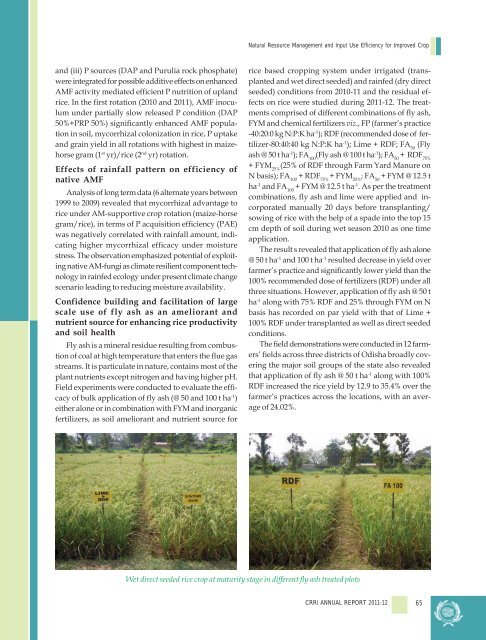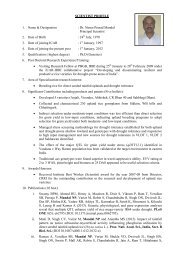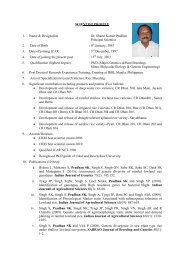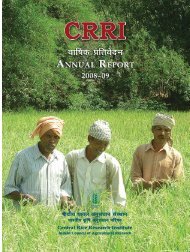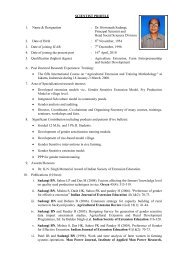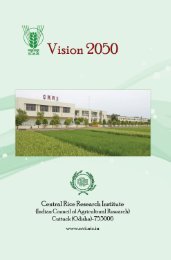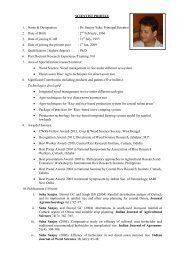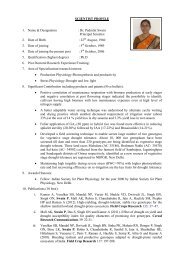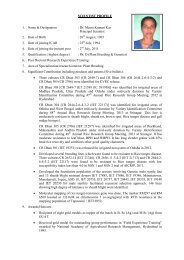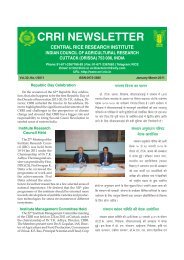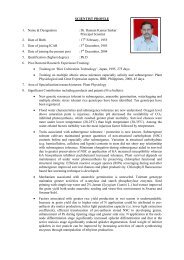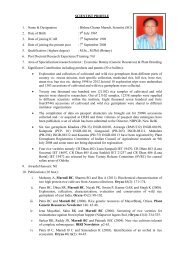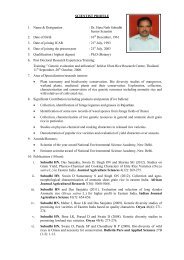Central Rice Research Institute Annual report...2011-12
Central Rice Research Institute Annual report...2011-12
Central Rice Research Institute Annual report...2011-12
You also want an ePaper? Increase the reach of your titles
YUMPU automatically turns print PDFs into web optimized ePapers that Google loves.
Natural Resource Management and Input Use Efficiency for Improved Crop<br />
and (iii) P sources (DAP and Purulia rock phosphate)<br />
were integrated for possible additive effects on enhanced<br />
AMF activity mediated efficient P nutrition of upland<br />
rice. In the first rotation (2010 and 2011), AMF inoculum<br />
under partially slow released P condition (DAP<br />
50%+PRP 50%) significantly enhanced AMF population<br />
in soil, mycorrhizal colonization in rice, P uptake<br />
and grain yield in all rotations with highest in maizehorse<br />
gram (1 st yr)/rice (2 nd yr) rotation.<br />
Effects of rainfall pattern on efficiency of<br />
native AMF<br />
Analysis of long term data (6 alternate years between<br />
1999 to 2009) revealed that mycorrhizal advantage to<br />
rice under AM-supportive crop rotation (maize-horse<br />
gram/rice), in terms of P acquisition efficiency (PAE)<br />
was negatively correlated with rainfall amount, indicating<br />
higher mycorrhizal efficacy under moisture<br />
stress. The observation emphasized potential of exploiting<br />
native AM-fungi as climate resilient component technology<br />
in rainfed ecology under present climate change<br />
scenario leading to reducing moisture availability.<br />
Confidence building and facilitation of large<br />
scale use of fly ash as an ameliorant and<br />
nutrient source for enhancing rice productivity<br />
and soil health<br />
Fly ash is a mineral residue resulting from combustion<br />
of coal at high temperature that enters the flue gas<br />
streams. It is particulate in nature, contains most of the<br />
plant nutrients except nitrogen and having higher pH.<br />
Field experiments were conducted to evaluate the efficacy<br />
of bulk application of fly ash (@ 50 and 100 t ha -1 )<br />
either alone or in combination with FYM and inorganic<br />
fertilizers, as soil ameliorant and nutrient source for<br />
rice based cropping system under irrigated (transplanted<br />
and wet direct seeded) and rainfed (dry direct<br />
seeded) conditions from 2010-11 and the residual effects<br />
on rice were studied during 2011-<strong>12</strong>. The treatments<br />
comprised of different combinations of fly ash,<br />
FYM and chemical fertilizers viz., FP (farmer’s practice<br />
-40:20:0 kg N:P:K ha -1 ); RDF (recommended dose of fertilizer-80:40:40<br />
kg N:P:K ha -1 ); Lime + RDF; FA 50<br />
(Fly<br />
ash @ 50 t ha -1 ); FA 100<br />
(Fly ash @ 100 t ha -1 ); FA 50<br />
+ RDF 75%<br />
+ FYM 25%<br />
(25% of RDF through Farm Yard Manure on<br />
N basis); FA 100<br />
+ RDF 75%<br />
+ FYM 25%<br />
; FA 50<br />
+ FYM @ <strong>12</strong>.5 t<br />
ha -1 and FA 100<br />
+ FYM @ <strong>12</strong>.5 t ha -1 . As per the treatment<br />
combinations, fly ash and lime were applied and incorporated<br />
manually 20 days before transplanting/<br />
sowing of rice with the help of a spade into the top 15<br />
cm depth of soil during wet season 2010 as one time<br />
application.<br />
The result s revealed that application of fly ash alone<br />
@ 50 t ha -1 and 100 t ha -1 resulted decrease in yield over<br />
farmer’s practice and significantly lower yield than the<br />
100% recommended dose of fertilizers (RDF) under all<br />
three situations. However, application of fly ash @ 50 t<br />
ha -1 along with 75% RDF and 25% through FYM on N<br />
basis has recorded on par yield with that of Lime +<br />
100% RDF under transplanted as well as direct seeded<br />
conditions.<br />
The field demonstrations were conducted in <strong>12</strong> farmers’<br />
fields across three districts of Odisha broadly covering<br />
the major soil groups of the state also revealed<br />
that application of fly ash @ 50 t ha -1 along with 100%<br />
RDF increased the rice yield by <strong>12</strong>.9 to 35.4% over the<br />
farmer’s practices across the locations, with an average<br />
of 24.02%.<br />
Wet direct seeded rice crop at maturity stage in different fly ash treated plots<br />
CRRI ANNUAL REPORT 2011-<strong>12</strong><br />
65


